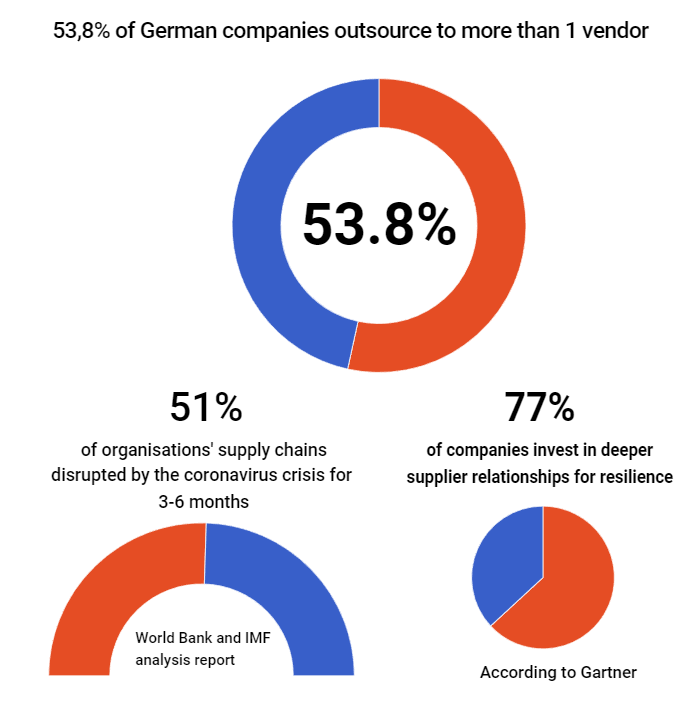How to Manage IT in Uncertain Times: Adopting a Multi-Vendor Approach
The world never stops surprising us. It’s difficult to predict what a new day can bring. A new pandemic, or crisis, or any other unexpected event that can catch us off-guard. This is one of the main reasons more and more companies are choosing a multi-vendor strategy. Diversification provides additional support in case something goes not as planned.
German IT Outsourcing Intelligence Report says, of 764 German companies, 53.8% choose a multi-vendor approach. They use diversification because working with one vendor presents certain risks, in terms of:
- Business continuity. An unexpected event can stop your third-party vendor from conducting business. This will impact your organization as a result;
- Geopolitics. If your vendor is situated in the country where there are any conflicts or possibilities of unrest, this might lead to disruption and their inability to continue meeting deadlines and working on your projects;
- Operational continuity. This results from the vendor’s inefficient or broken internal processes or systems;
- Information security. This risk is connected with your vendor’s security vulnerabilities, such as cyberattacks or data breaches;
- Compliance. Your business is at a great risk if your vendor doesn’t comply with the laws and regulations concerning the products and services your company uses;
- Financial obligations. If the financial condition of your vendor itself leaves much to be desired, this might lead to their inability to meet contractual obligations and provide products and services;
- Strategic compatibility. It occurs when your vendor’s actions are diametrically opposed to your organization strategic objectives;
- Reputation. This risk includes all the ways your vendor can directly or indirectly damage your reputation, brand, or name.
All these reasons and risk factors make more and more companies around the globe rely on a multi-vendor approach. Even if one of the vendors is out of play, the other one continues developing the product, meeting deadlines, fixing bugs, and making sure everything keeps going.

Diversification Works in Two Cases
The first one is when you work with in-house developers and want to scale your team up to take on new projects. You might not have enough experienced developers and seek access to a larger talent pool. Or you might need to go to the market faster. But it’s impossible to do this with the current number of developers in your company. One more reason is that you might want your in-house developers to focus on the core tasks, while your vendor is busy with some additional issues or side projects.
The second case is when you already outsource your software development to one vendor but you’re facing some challenges, like:
- your vendor has significantly increased the prices;
- you’re dependent on the current provider;
- the vendor misses deadlines, disrupts work, puts your reputation or security at risk;
- the quality of work is poor;
- there is a lack of expertise, an urge to have access to a larger talent pool, innovations, etc.
What Advantages Does a Multi-Vendor Approach Bring to Your Business?
Risk mitigation
There are certain vendor-related risks (in terms of business continuity, compliance, security, reputation, etc.) that can make you realize your vendor isn’t the right technical partner for your company. Besides, some unexpected events can make your vendor stay out of the game. Or they can even bail on you at the most inappropriate moment. In this case, you still have one more vendor to continue working on the project and bringing benefits to your business.
Less dependency on one vendor
If you collaborate with only one provider, it’s easier for them to realize you don’t have any alternatives and the whole project is dependent on them and them alone. Thus, they feel free to establish higher prices, dictate their terms and conditions, and break deadlines. Choosing a multi-vendor approach, on the other hand, creates increased competition between the vendors, making them show their expertise and high quality of work. You’ll be able to negotiate the best prices and avoid the vendor lock-in.
Greater competence
When working on a complicated large-scale project, it may come in handy to have access to a larger talent pool, to have people in your team experienced in different domains and technologies. This gives you more options, innovations, and more opportunities to deploy the best solutions.
Faster scaling up
Whether you work with in-house developers or a single vendor, you might not have enough professionals to take on a new project. Choosing a multi-vendor approach provides you with the necessary amount of people for a faster go-to-market. Besides, your in-house developers can focus on some core business tasks, while your vendors are busy with additional issues and side projects.
Best-of-breed quality
A single vendor has expertise in a limited number of technologies and areas. Thus, by choosing a multi-vendor approach, you’re expanding the number of domains and getting best-of-breed quality.
More frequent product upgrades
When working with multiple vendors, each of them is responsible for their own part of the project. Thus you can get faster and more frequent upgrades that affect the overall outcome of the project.
Price negotiation
Because of the competitive atmosphere in the team and the absence of vendor lock-in, it is easier to negotiate the most attractive price for yourself. When working in a multi-vendor atmosphere, it’s more complicated for a vendor to establish unreasonably high prices. Because their services can be substituted by something more affordable.
Successful Case Studies
There are a few examples from different industries when working with a few vendors turned out to be more secure and beneficial than cooperation with only one.
For example, a case with Indian service provider Satyam. It was admitted to falsifying company accounts in 2009. All clients of Satyam who relied only on the services of the provider faced considerable losses. Such troubles are not a rare thing when dealing with one supplier. It makes you dependent on one vendor and takes urgent measures in case your supplier quits on you at the most inconvenient point.
One more company that chose a multi-vendor strategy is Adidas. By 2010 it had a long-term relationship with the single vendor. However, it incorporated multi-sourcing from 2 vendors in 2012. The strategy turned out to be very beneficial for Adidas. The cost of the company was reduced by 20%. Furthermore, in response to the multi-sourcing of a global IT group the service sourcing and software development, the number of defects massively cut to half. It was a massive improvement in the quality of production.
Choosing a multi-vendor approach provides stability and also gives you positional advantage and strength. When you have options to choose from, you do not need to take urgent measures in case something goes wrong. It’s easier to scale the team, negotiate prices, or some contract terms. You simply do have the freedom of choice. And that is one of the essential grounds for building a thriving business.

Disadvantages of a Multi-Vendor Approach
Each coin has two sides, and suffice it to say, a multi-vendor approach is no exception.
- Managing several vendors simultaneously requires more time and resources. You may experience issues with process management, tasking, and product quality assurance. However, there is a way to get rid of this challenge. If you choose a vendor that has substantial experience in working with multiple large-scale companies, then it already has well-established processes and is well aware of how to facilitate and accelerate the cooperation. A responsible and trustworthy vendor will make sure you get access to all the tools to control every stage of the project and will constantly keep you in touch (via Zoom, Skype, Slack, Jira, etc.). In this case, you won’t have to worry about your project progress and spend much time on management;
- One more challenge is integration difficulties. When multiple vendors develop different components of the same project, it can be difficult to integrate them together and thus require more time and money. However, if we talk about the vendors experienced in working in large teams, showing successful teamwork on numerous projects, there is not much to worry about. Besides, you’re more likely to get the highest quality of the product. Each team is responsible for a certain area it has expertise in and can bring innovations and a fresh way of thinking to your project.
Bottom Line
To sum this all up, a multi-vendor approach has turned out to be a beneficial strategy for many large-scale global companies. It helps you ease many risks and get significant advantages (such as expertise, innovations, security, high quality of work, faster road to the market, etc.) However, you should choose this or that approach according to your particular project and its specificities. Weighing a list of pros and cons may come in handy when making a decision.
For small projects, working with a single vendor can be more rational. But for large, global, and complex projects or projects requiring professionals with expertise in different domains, collaboration with multiple vendors is a win-win approach.
New articles

See more

See more

See more

See more

See more
